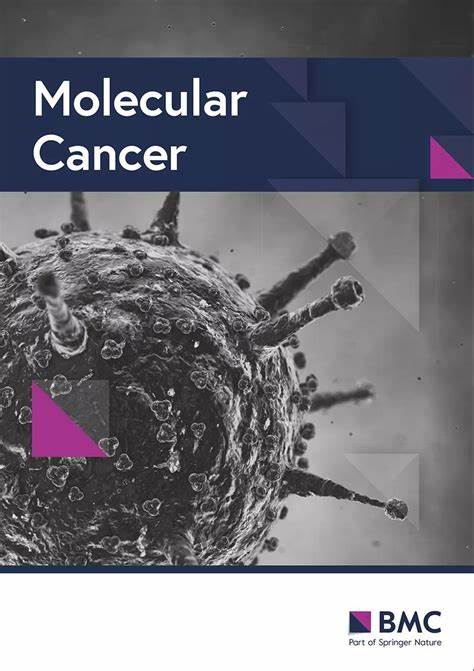Jab1通过调节HRR mRNA稳定性调节三阴性乳腺癌中PARP抑制剂的敏感性
IF 33.9
1区 医学
Q1 BIOCHEMISTRY & MOLECULAR BIOLOGY
引用次数: 0
摘要
三阴性乳腺癌(TNBC)是一种高度侵袭性的乳腺癌亚型,在所有乳腺癌亚型中死亡率最高,主要原因是缺乏可行的治疗靶点。尽管聚(adp -核糖)聚合酶抑制剂(PARPi)在TNBC同源重组缺陷(HRD)患者中显示出有希望的治疗效果,但其临床益处仍然有限,迫切需要新的靶点来增强PARPi的疗效。本研究探讨了Jab1在调节同源重组修复(HRR)相关rna稳定性中的作用,并评估了其作为提高TNBC中PARPi敏感性的治疗靶点的潜力。RNA-Seq分析显示,shrna介导的Jab1敲低深刻影响TNBC细胞的HRR和DNA复制过程。通过核运行试验、RNA免疫沉淀、RNA下拉试验和RIP-Seq,我们发现Jab1是一种潜在的RNA结合蛋白(RBP),通过与外泌体复合物竞争来稳定hrr相关mrna。利用CSN5i-3对Jab1进行遗传和药理学抑制,评估其对HRR效率、电离辐射(IR)敏感性和PARPi敏感性的影响。进行了全面的体外检测,包括克隆生存检测、PrestoBlue检测、细胞凋亡检测、DR-GFP报告基因检测、qRT-PCR、Western blot、comet检测和免疫荧光检测。采用斑马鱼异种移植、裸鼠异种移植和同基因原位小鼠模型来评估体内疗效,以检验联合PARPi抑制Jab1的治疗效果。在TNBC中发现Jab1过表达,并与不良临床结果相关。功能分析显示,与BRCA突变状态无关,Jab1敲低可损害HRR,增加DNA损伤积累,并使TNBC细胞对IR和PARPi敏感。从机制上讲,Jab1通过其MPN结构域发挥RBP的作用,通过竞争性拮抗RNA外泌体复合物来稳定hrr相关转录物。CSN5i-3对Jab1的药理学抑制再现了这些效应,并与PARPi协同诱导合成致死。在多个临床前模型中,该组合显著抑制肿瘤生长并促进细胞凋亡。这项研究揭示了Jab1作为RBP的新作用,特别是通过其MPN结构域与HRR相关RNA之间的相互作用,调节RNA稳定性并维持HRR能力。靶向Jab1是在TNBC中药理学诱导HRD和增强PARPi治疗效果的一种有前景的策略。这种联合方法可能对改善TNBC患者的临床结果具有转化价值。本文章由计算机程序翻译,如有差异,请以英文原文为准。
Jab1 regulates HRR mRNA stability to modulate PARP inhibitor sensitivity in triple-negative breast cancer
Triple-negative breast cancer (TNBC) is a highly aggressive breast cancer subtype associated with the highest mortality rate among all breast cancer subtypes, primarily due to the absence of actionable therapeutic targets. Although poly (ADP-ribose) polymerase inhibitors (PARPi) have shown promising therapeutic effects in TNBC patients harboring homologous recombination deficiency (HRD), their clinical benefit remains limited, highlighting an urgent need for novel targets that enhance PARPi efficacy. This study investigates the role of Jab1 in regulating the stability of homologous recombination repair (HRR)-related RNAs and evaluates its potential as a therapeutic target to enhance PARPi sensitivity in TNBC. RNA-Seq analysis revealed that shRNA-mediated Jab1 knockdown profoundly affected HRR and DNA replication processes in TNBC cells. Using Nuclear Run-On Assay, RNA Immunoprecipitation, RNA Pull-Down Assay, and RIP-Seq, we identified Jab1 as a potential RNA-binding protein (RBP) that stabilizes HRR-related mRNAs by competing with the exosome complex. Genetic and pharmacological inhibition of Jab1 (using CSN5i-3) were evaluated for their impact on HRR efficiency, ionizing radiation (IR) sensitivity, and PARPi sensitivity. A comprehensive panel of in vitro assays was performed, including clonogenic survival assays, PrestoBlue assays, apoptosis assays, DR-GFP reporter assays, qRT-PCR, Western blot, comet assays, and immunofluorescence. In vivo efficacy was assessed using zebrafish xenografts, nude mouse xenografts, and syngeneic orthotopic mouse models to examine the therapeutic effect of Jab1 inhibition in combination with PARPi. Jab1 was found to be overexpressed in TNBC and correlated with poor clinical outcomes. Functional analyses revealed that Jab1 knockdown impaired HRR, increased DNA damage accumulation, and sensitized TNBC cells to IR and PARPi, irrespective of BRCA mutation status. Mechanistically, Jab1 functioned as an RBP through its MPN domain, stabilizing HRR-related transcripts by competitively antagonizing the RNA exosome complex. Pharmacological inhibition of Jab1 using CSN5i-3 recapitulated these effects and synergized with PARPi to induce synthetic lethality. In multiple preclinical models, this combination significantly suppressed tumor growth and promoted apoptosis. This study uncovers a novel role for Jab1 as an RBP, specifically through interactions between its MPN domain and HRR-related RNAs, regulating RNA stability and maintaining HRR competency. Targeting Jab1 represents a promising strategy to pharmacologically induce HRD and enhance the efficacy of PARPi therapies in TNBC. This combination approach may hold translational value for improving clinical outcomes in patients with TNBC.
求助全文
通过发布文献求助,成功后即可免费获取论文全文。
去求助
来源期刊

Molecular Cancer
医学-生化与分子生物学
CiteScore
54.90
自引率
2.70%
发文量
224
审稿时长
2 months
期刊介绍:
Molecular Cancer is a platform that encourages the exchange of ideas and discoveries in the field of cancer research, particularly focusing on the molecular aspects. Our goal is to facilitate discussions and provide insights into various areas of cancer and related biomedical science. We welcome articles from basic, translational, and clinical research that contribute to the advancement of understanding, prevention, diagnosis, and treatment of cancer.
The scope of topics covered in Molecular Cancer is diverse and inclusive. These include, but are not limited to, cell and tumor biology, angiogenesis, utilizing animal models, understanding metastasis, exploring cancer antigens and the immune response, investigating cellular signaling and molecular biology, examining epidemiology, genetic and molecular profiling of cancer, identifying molecular targets, studying cancer stem cells, exploring DNA damage and repair mechanisms, analyzing cell cycle regulation, investigating apoptosis, exploring molecular virology, and evaluating vaccine and antibody-based cancer therapies.
Molecular Cancer serves as an important platform for sharing exciting discoveries in cancer-related research. It offers an unparalleled opportunity to communicate information to both specialists and the general public. The online presence of Molecular Cancer enables immediate publication of accepted articles and facilitates the presentation of large datasets and supplementary information. This ensures that new research is efficiently and rapidly disseminated to the scientific community.
 求助内容:
求助内容: 应助结果提醒方式:
应助结果提醒方式:


